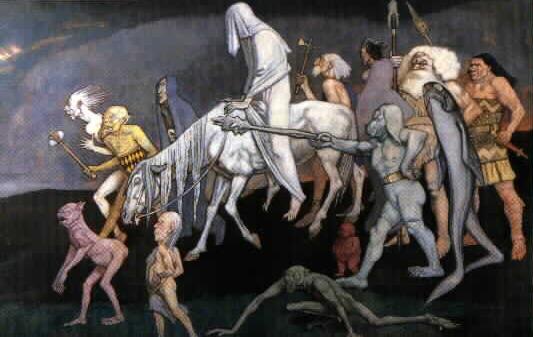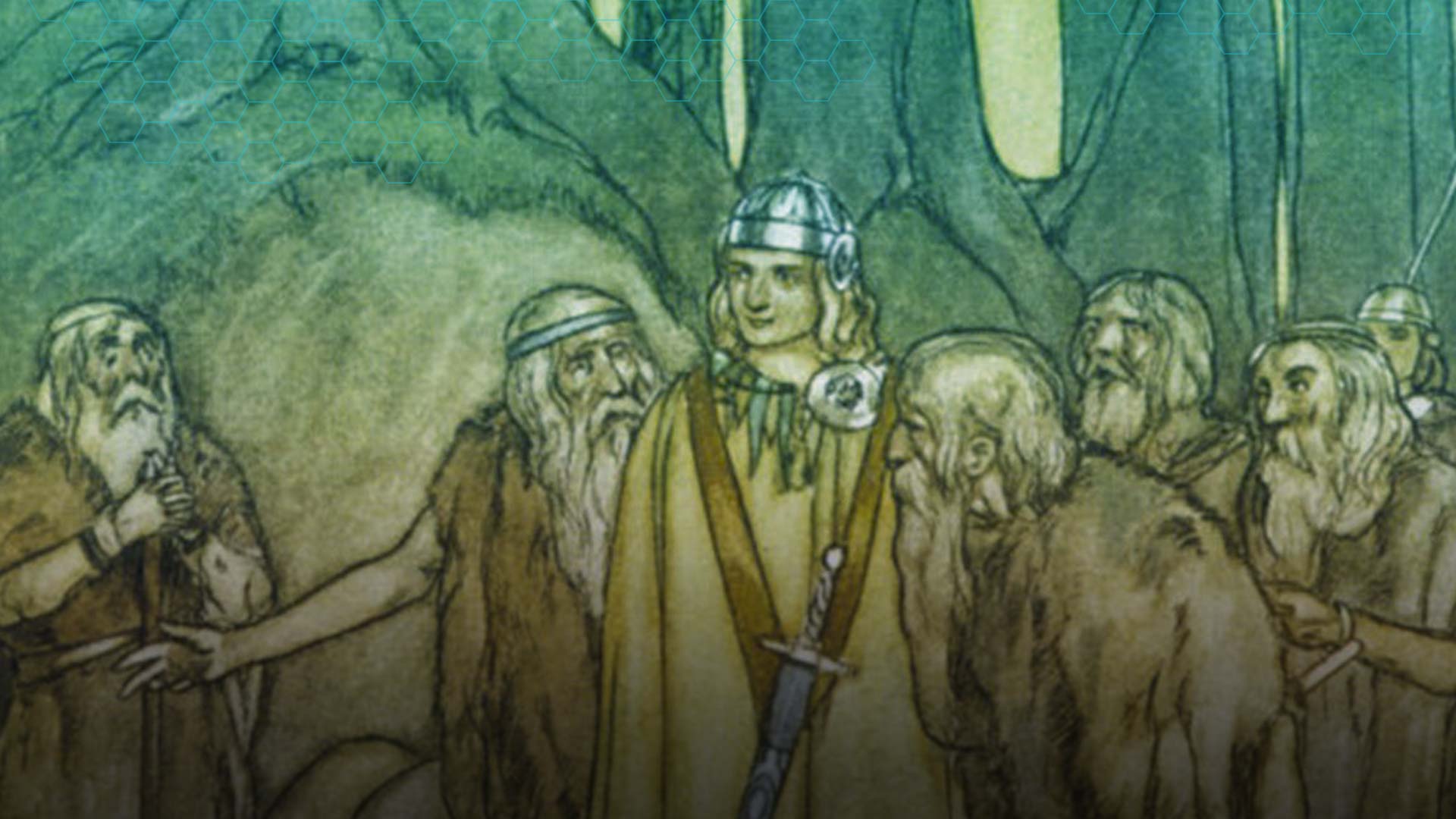Ireland is a country famous for its storytellers. In fact, in ye olden days, Celtic history was passed down not in dusty old scrolls and boring lectures taught by dusty old professors, but in epic, lyrical poems and tales performed by bards and traditional storytellers known as seanchaí (pronounced “shan-a-khee”). Today, of course, such stories can be told in a myriad of mediums, whether written, spoken, sung, or displayed on a high-definition 3D screen at IMAX.
In honor of St. Patrick’s day, it seems only appropriate to explore the most recently developed means of spinning yarns – video games – and the influence Celtic (and in particular, Irish) mythology has had on them. Below are listed just a few of the legendary characters most commonly found in games, and where they came from. Rather than a complete, detailed list, consider this a delectable, bite-sized tidbit of information, easily digested in between a plate of shepherd’s pie and a pint of Jameson’s. Sláinte!
Banshees

Put simply, banshees are female spirits associated with death. Most modern depictions draw on the darker takes on the legend, which cast banshees as terrifying fae creatures who take the form of hags or the deformed undead, with claw-like hands, a gaze so full of agony and fury it could not be met with mortal eyes, and a keening wail which could shatter glass and drive a man to madness or death. More traditionally, however, banshees were harbingers, rather than bringers, of death; their cries portended a death, usually violent, which would soon come to pass. Some versions cast the banshees as the ghosts of brutally murdered women, who sought to warn the living with their cries before they met the same fate.
Banshees are one of the most commonly found monsters in any medium. In World of Warcraft, banshees are the tormented spirits of elf women who suffered a cruel fate, and in Warcraft III they are equipped with a sound-wave ranged attack. Similarly, in Silent Hill: Downpour, Screamers take the forms of undead women who emit ear-splitting screams which both damage and temporarily incapacitate their victims. In Banshee’s Last Cry, the original Japanese game’s sickle weasel is replaced in the English localization with a banshee, and last year City State Entertainment released concept art for their upcoming title, Camelot Unchained, which depicted a banshee as a spectral, headless woman carrying her own head in her left hand.
The Fomoiri

The Fomoiri were a divine(ish) race of beings who were said to inhabit Ireland way back in the day. Though often described as demonic giants akin to the Titans – either one-eyed, one-armed, and one-legged, or sporting the heads of goats and horses – they have sometimes been portrayed as exceedingly beautiful. Over time the term “Fomorian” came to be synonymous with “pirate,” because they were said to have come to Ireland by ship. They are often linked to the forces of chaos and nature, in direct opposition to the Irish gods of human civilization, the Tuatha Dé Danann.
According to the myths, the Fomoiri fended off early human invasions by inflicting enemies with plague, enslaving any survivors and demanding a harsh tribute of two thirds of their victims’ children, crops, and cattle. Those who dared resist had their noses cut off. Eventually the Tuatha Dé Danann arrived and took control of Ireland, only to name a half-Fomorian, Bres the Beautiful, as their ruler. Bres, in true Fomorian form, enslaved the people once again, and when he was (inevitably) ousted, he raised an army to take back the throne. This time, however, the Tuatha Dé Danann emerged victorious, and drove the Fomorians into the sea.
Their closest video game counterparts appear in Mabinogi, in which the Fomorians are a race of creatures seeking to forcibly reshape the world to their liking. Much of their in-game history is based on the original mythology. In Vindictus, the term Fomorian refers to a member of any species which fought against humans during the Fomorian War, while in the Final Fantasy XI MMORPG, Fomors are the spirits of warriors slain in battle. Black and White Fomors are goat-like demons in Castlevania: Order of Ecclesia, and Fomorians appear as enemies in Nethergate.
Caladbolg, The Lightning Sword

Caladbolg (pronounced “cuh-lahd-bahl”), or Caladcholg, was the sword of Fergus mac Róich, a hero from the Ulster Cycle of Irish mythology. A two-handed sword of cosmic power, it was said to create a rainbow-like arc in the air when swung. Fergus wielded Caladbolg in many a victorious battle, eventually using it to successfully defend his homeland from an invasion by the king of Ulster. When the battle was won, he spared the enemy king, instead cleaving three nearby hills in half with three massive strikes. Just to show he could.
Fergus’ magical sword has appeared many times in games, usually as a higher-level attainable weapon. In the Final Fantasy series, it is often Tidus’s ultimate weapon, referred to in FFX as a “celestial” weapon powered by the Sun Crest and Sun Sigil. Mabinogi features a version which sparks with electricity. In the Castlevania titles Aria of Sorrow and Dawn of Sorrow, Kaladbolg is a powerful dark weapon which, instead of a rainbow, trails a blood-red arc in its wake. Guild Wars 2, Fire Emblem: Radiant Dawn, and the Bard’s Tale remake also contain their own versions, and Fate/Stay Night features an imperfect copy, dubbed Caladbolg II: The Fake Spiral Sword, which can pierce through any material.
Cú Chulainn, The Hound of Ulster

Cú Chulainn (pronounced “coo-hoo-lin”) was a demigod who acquired his name when he killed a dog in self-defense. As recompense, he offered to serve its owner, Culann, as his new guard dog until a replacement could be found. Cú Chulainn was known for his bloodthirsty battle rage, which distorted his features so terribly as to transform him into a monster. To win the hand of his love, the princess Emer, he trained with the warrior goddess Scáthach. She taught him to wield the Gae Bolg, a lethal spear carved from the bones of a sea monster which shot barbs into its victims’ skin, causing instant death. He later defeated her sister Aoife in battle.
He defended Ulster twice from invading armies, and when Princess Emer’s father, Lord Fargol, tried to prevent her marriage to the hero by locking her in a tower, Cú Chulainn stormed the castle, murdered the guards, tossed Lord Fargol over the wall, rescued the princess, and then sacked the treasury on the way out for good measure. Cú Chulainn did not meet his end until many years later, when he refused the goddess Morrigan’s attempts to seduce him. In retaliation, she tried to trick him into breaking his lifelong oath to never eat dog-meat. When that failed, she sent druids to take his life. One mortally wounded him with an enchanted spear, and before Cú Chulainn died he tied himself upright to a rock, so that even in death he could stand to face his foes.
Cú Chulainn appeared as the main protagonist in the 1980s adventure classics Tir Na Nog and Dun Darach, which both referenced many elements of the legend. He will appear as the player character again in the upcoming title In Cúchulainn’s Footsteps. In Fate/Stay Night he is renamed Lancer, the “Blue Spearman of the Wind,” and the Gae Bolg bears a curse which renders any wounds it inflicts impossible to heal. In Persona 3, he grants the player the Shadow Hound spell, and in FES he can be used to create the Gae Bolg, which deals heavy wind damage. His monstrous form appeared in the Final Fantasy series as Cúchulainn the Impure, a poison-type creature which looked a bit like the psychedelic version of Oogie Boogie. He was a demonic figure in the Shin Megami Tensei series, and his teacher Scathach made a cameo during a quest in Strange Journey. He was also in Omikron: The Nomad Soul as Kushulai’n.
The Cat Sidhe

The cat sidhe (pronounced “cat shee”), a fairy cat from Irish and Scottish lore, is said to be a large black cat with a white spot on its breast. A variant on the tale claimed it was a witch who, after transforming into a cat nine times, was trapped forever in feline form. On Samhain, tradition said to leave a saucer of milk out to avoid being cursed by the cat sidhe. It was known to steal souls from the dead before the gods could claim them; as such, various rituals to distract the cat sidhe would be performed during the Feill Fadalach (the “Late Wake”) until the funeral. These included games, riddles, catnip offerings, and music. No fires were allowed in the room with the body, as the cat sidhe would be attracted to the warmth.
Most gamers, of course, will know the cat sidhe better as Cait Sith, the adorable robo-kitty of the Final Fantasy series. Folklore, set in the Otherworld of Celtic mythology, includes a large Cait Sidhe with what appear to be butterfly wings sprouting from its head. In La Mulana, Cait Sith is a cat which rolls around on a giant inflated ball, while Legends of the Cryptids contains two cards which depict Cait Sidhe as a girl trick-or-treating on Halloween. A character in the visual novel Yume Miru Kusuri introduces herself as “Cat Sidhe Nekoko” and claims to be a fairy searching for her home. The cat sidhe has also appeared, bearing strong resemblance to Puss in Boots, in Magician’s Quest: Mysterious Times, the Shin Megami Tensei series, Mabinogi, and Blood Brothers.


 …WOOLY DESERVES BETTER LOL!
…WOOLY DESERVES BETTER LOL!